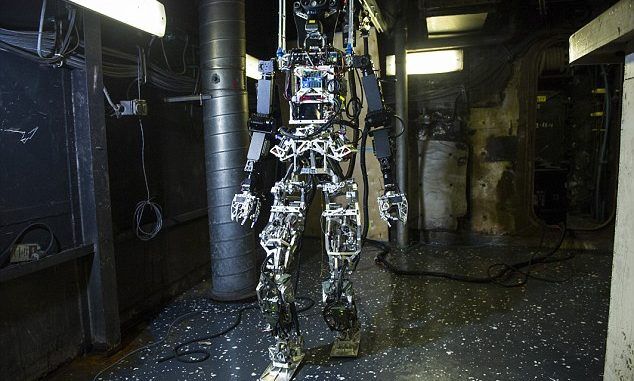
The U.S. Navy’s new firefighting robot – named SAFFiR – can walk around a ship, use thermal imaging, has infrared stereo vision and can put out fires, with no help from humans at all!
The Daily Mail reports:

BYPASS THE CENSORS
Sign up to get unfiltered news delivered straight to your inbox.
You can unsubscribe any time. By subscribing you agree to our Terms of Use
Standing five feet ten and weighting 143lb, he could soon be fighting fires for the US Navy.
The firefighting robot prototype was unveiled at the Naval Future Force Science & Technology expo in Washington.
In simulated fires, it has already walked across uneven floors, used thermal imaging to identify overheated equipment, and used a hose to extinguish a small fire.
‘We set out to build and demonstrate a humanoid capable of mobility aboard a ship, manipulating doors and fire hoses, and equipped with sensors to see and navigate through smoke,’ said Dr. Thomas McKenna program manager for human-robot interaction and cognitive neuroscience at the Office of Naval Research (ONR).
‘The long-term goal is to keep Sailors from the danger of direct exposure to fire.’
Developed by researchers at Virginia Tech, the two-legged, or bipedal, humanoid robot
The Shipboard Autonomous Firefighting Robot SAFFiR stands 5 feet 10 inches and weighs 143 pounds.
The unique mechanism design on the robot equips it with super-human range of motion to maneuver in complex spaces.
‘Balancing on any type of terrain that’s unstable – especially for bipedal robots – is very difficult,’ said Brian Lattimer, associate professor for mechanical engineering at Virginia Tech.
‘Whole-body momentum control allows for the robot to optimize the locations of all of its joints so that it maintains its center of mass on uncertain and unstable surfaces.’
Sensors, including infrared stereovision and a rotating laser for light detection and ranging (LIDAR), enable the humanoid to see through dense smoke.
It is programmed to take measured steps and handle hoses on his own, but for now, takes his instruction from researchers at computer console.
‘The robot has the ability to do autonomous tasks, but we have a human in the loop to allow an operator to intervene in any type of task that the robot’s doing,’ Lattimer said.
McKenna plans to sponsor a more advanced design as part of the long-term investigational research program.
Blueprints include equipping the robot with enhanced intelligence, communications capabilities, speed, computing power and battery life for extended applications.
‘We have taken a look at other kinds of sensors that you can put on these robots,’ he said.
‘For instance, a bipedal robot could be configured to take shipboard measurements, scan for corrosion and leaks, and identify changes to the shape of the room from its original configuration.
‘By taking on these time-consuming tasks, SAFFiR could free up Sailors for jobs that more fully take advantage of their training and technical skillsets.’
Even with added intelligence, however, SAFFiR will take its instruction from Sailors and ‘fire bosses’ working remotely in the event of a fire or other dangerous event.
‘We’re working toward human-robot teams’ McKenna said.
‘It’s what we call the hybrid force: humans and robots working together.’
Jacqui Deevoy
These days, as a journalist, writer and editor I write a wide variety of features, frivolous and serious. I work mainly for women's magazines and national newspapers and also enjoy writing for independent news outlets and websites - the sort that publish stories the mainstream media fail to report.
Email: jacqui.deevoy@gmail.com
Latest posts by Jacqui Deevoy (see all)
- Grief-Stricken Mum Euthanized in NHS Hospital 12 Days After Husband’s Death - October 19, 2023
- UK Gov’t Caught Issuing Hospitals ‘Expiry Dates’ For Patients - October 19, 2023
- We Will NEVER Forgive Them for What They Did to Our Elderly - November 7, 2022

The Fire Terminator.